March 17, 2023
Air Date: March 17, 2023
FULL SHOW
SEGMENTS

Broken Promise for the Arctic
View the page for this story
A massive new oil drilling project in the Arctic just got the green light from President Biden despite his promises for no new drilling on federal lands. Environmental law expert Pat Parenteau joins Host Steve Curwood to explain the climate contradictions within the White House and what could happen next. (14:31)

Beyond the Headlines
View the page for this story
PFAS “forever” chemicals are everywhere, including in toilet paper, Peter Dykstra reveals in this week’s chat with Living on Earth’s Bobby Bascomb. Also, everything’s big in Texas, including renewable energy, and the state is by far the biggest producer of wind and solar in the U.S. And 55 years ago, prospectors struck black gold on Alaska’s north slope, forever changing the state’s economy and environment. (04:11)
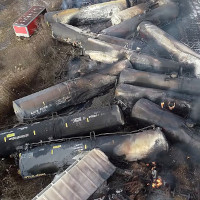
EPA Drops the Ball in East Palestine
View the page for this story
The people of East Palestine, Ohio were left in the dark about toxic chemical risks in the wake of the fiery train derailment, says Judith Enck, a former regional administrator of the EPA. Her commentary calls out the EPA’s delayed and weak response and urges the agency to take steps to regain the public’s trust. (04:11)

The Next Chapter of the Living on Earth Book Club
In the coming decades millions of Americans will be uprooted by wildfires, floods, and rising seas in the largest migration in our country’s history. And many are already on the move. "The Great Displacement: Climate Change and the Next American Migration" by Jake Bittle compassionately tells their stories and uncovers how government and insurance policies are shaping who rebuilds and who retreats. Tune in on March 23rd for the next Living on Earth Book Club event – live with Jake Bittle. ()

Saving the Second Lung of the Planet
View the page for this story
The Congo Basin in Central Africa is a critical biodiversity hotspot and linchpin in the fight against climate disruption. Conservationist Irene Wabiwa joins Host Steve Curwood to discuss the urgent need to turn the United Nations’ recent promises to protect biodiversity into reality in the Congo and around the world. (08:19)

Jane Goodall on Helping People to Help Nature
View the page for this story
Jane Goodall is on a mission to protect habitat worldwide by empowering local communities to develop sustainably. She joins Host Steve Curwood for an in-depth conversation about this holistic approach to conservation and how it all started when she was just ten years old and dreamed of studying wild animals in Africa. (15:06)
Show Credits and Funders
Show Transcript
230317 Transcript
HOSTS: Steve Curwood
GUESTS: Jane Goodall, Pat Parenteau, Irene Wabiwa
REPORTERS: Peter Dykstra, Judith Enck
[THEME]
CURWOOD: From PRX – this is Living On Earth.
[THEME]
CURWOOD: I’m Steve Curwood.
President Biden approves the Willow Oil Drilling project in Alaska despite campaign pledges to stop all new drilling on public land.
PARENTEAU: This is not one like some of the others where courts have ordered the administration to issue leases, nor has Congress. So neither Congress nor the courts are ordering Biden to do this. He's making this decision on his own and he's going to have to own it.
CURWOOD: Also famed primatologist Jane Goodall and her lifelong call to action.
GOODALL: If we get together we can start to heal some of the scars we’ve inflicted on poor old planet earth. Slow down climate change, slow down loss of biodiversity these two existential threats that we face.
CURWOOD: That and more this week on Living on Earth – Stick Around!
[NEWSBREAK MUSIC: Boards Of Canada “Zoetrope” from “In A Beautiful Place Out In The Country” (Warp Records 2000)]
[THEME]
Broken Promise for the Arctic
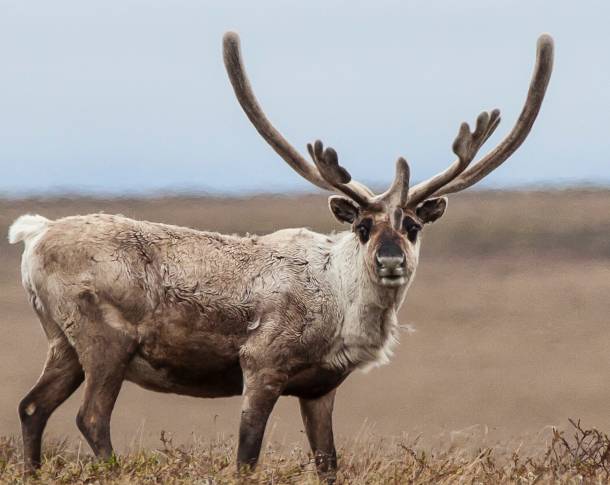
The community and people of Anaktuvuk Pass, the Nunamiut people, have expressed their concern that the Willow oil project will threaten their traditional caribou hunting and trading grounds by reducing the caribou population. Pictured above is Teshekpuk Caribou in the Northeast National Petroleum Reserve in Alaska. (Photo: Bob Wick, Bureau of Land Management, Flickr, CC BY 2.0)
CURWOOD: From PRX and the Jennifer and Ted Stanley Studios at the University of Massachusetts Boston, this is Living on Earth. I’m Steve Curwood.
Despite campaign promises to halt the extraction of fossil fuels from public lands, President Biden has approved the massive Willow Oil Project of ConocoPhillips on the North Slope of Alaska. It’s the largest planned drilling project in the US and could produce more than 180,000 barrels of oil a day. And if all that oil is burned it would release roughly 260 million tons of carbon dioxide a year, the same as putting 2 million more gasoline powered cars on the road. Activists call it a carbon bomb that would fan the flames of global warming and cost the public billions of dollars in climate related damages. When the question of drilling in the Arctic came up during the 2020 presidential campaign Mr. Biden was unequivocal.
BIDEN: Totally opposed to it, completely, totally opposed.
CURWOOD: Again and again, he made the same pledge.
BIDEN: No more drilling on federal lands. [APPLAUSE] period, period, period, period. The Arctic Circle is a disaster to do that. A big disaster in my view.
CURWOOD: But once in office the Biden Administration defended in federal court permits issued by the Trump Administration and ultimately gave Conoco Phillips the green light to proceed. Activists including Earthjustice and the Trustees for Alaska immediately filed lawsuits saying the Willow project would violate environmental protection laws by harming nearby residents as well as the pristine North Slope ecosystem, and literally pour more gasoline on the climate crisis. More than a million people signed petitions calling for President Biden to keep his word and block the project. Politicians on both side have spoken out, including progressive Democratic New York Congressman Jamaal Bowman.
BOWMAN: We are living in a climate catastrophe. We have one human race, we have one planet, and we have people organizing across the country to make sure that Willow project doesn't happen.
CURWOOD: But with the promise of jobs and billions of dollars in state revenues the project has support from some Alaskan labor unions and lawmakers including Republican Senator Dan Sullivan.
SULLIVAN: if you can't drill in the National Petroleum Reserve of Alaska, on a project that has the highest environmental standards in the world, lowest greenhouse gas emissions in the world. What project are you ever going to approve?
CURWOOD: For more, I’m joined now by Pat Parenteau, a former EPA regional counsel and emeritus professor at Vermont Law School. Welcome back to Living on Earth, Pat!
PARENTEAU: Thanks, Steve, good to be with you.
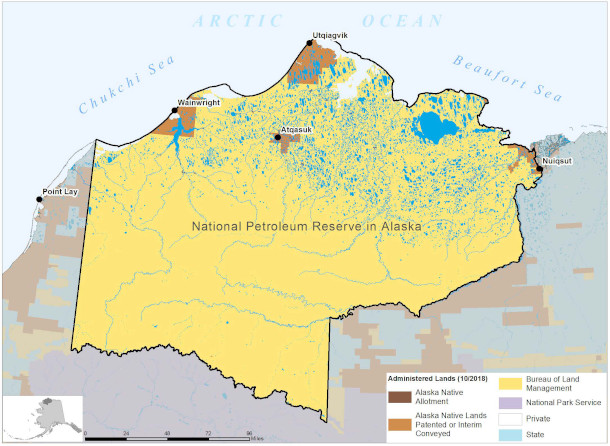
The National Petroleum Reserve in Alaska. (Photo: Bureau of Land Management, Public Domain)
CURWOOD: So I mean, what's the argument from the administration and move forward with what some call a carbon bomb, which seems to be in direct contradiction from the President's campaign promises?
PARENTEAU: Yeah. Well, here are the reasons given by the White House so far: One, they say we're locked in by the fact that leases have been issued. Conoco has legal rights to drill, which would expose the Biden administration to litigation and perhaps result in a requirement to compensate the companies if they were to cancel the leases. Secondly, you've got a real split in the native Inuit community in Alaska. The majority of the native corporations support the project because of course it's Alaska, oil and gas is a major source of revenue for everybody. Everybody in Alaska gets a check every year based on the amount of oil and gas that's developed. But the Nuiqsut community which is right next to the oil development, and is already living with existing oil and gas operations, is the most impacted native community and they of course, are 100% against further development of oil and gas. They've already experienced gas leaks from Conoco's existing pipeline within the last year, this happened, cause the village to evacuate. You know, the Biden administration is pointing to bipartisan support for the project because both Senators Murkowski and Sullivan support it both the senators are Republican, but the new house member Peltola is a Democrat and is in fact a Native woman and also supports it. But you know, the Biden administration is working at cross purposes. It's trying to electrify the transportation system with all deliberate speed, at the same time, awarding leases that are supposed to last for 30 years based on combustion engines. So it doesn't really make a lot of sense to pursue diametrically opposed policies. And of course, it doesn't make sense rationally. It apparently makes sense to the Biden administration politically.
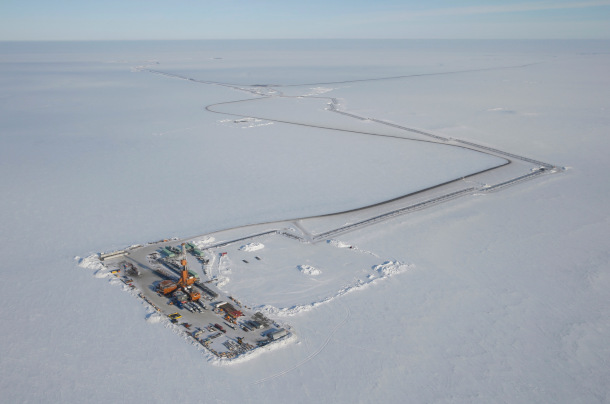
A drill site owned by ConocoPhillips in Alaska’s Western north slope. ConocoPhillips has major ownership interests in two of North America's largest oil fields, both located on Alaska's North Slope—Kuparuk, which the company operates, and Prudhoe Bay. (Photo: Courtesy of ConocoPhillips)
CURWOOD: ConocoPhillips got these leases for this area, I think originally back in like 1999, and of course, they have rights under the law to proceed to do their business there. What would it cost the Biden administration and the federal government if Biden says, well despite the fact that you're entitled to this, we're saying no. What will be the penalty?
PARENTEAU: Yeah, so that gets down to a question of compensation for basically breaching the contract. Leases, you can think of them as a contract and they are binding in that sense, they're legally enforceable contracts but, you know, you can breach a contract, you pay damages when you do so. And then the question is, how do you calculate the damage here? Certainly, whatever they paid for the bids would be returned. Plus, any I would say out of pocket expenses they've incurred. Now they haven't been allowed, they've done some exploration, so those costs could be recovered, but they haven't really done any, you know, significant investment in the infrastructure that they need. And I suppose the companies would argue we would also be entitled to lost profits, that's going to be more complicated. That would be the subject of litigation or settlement through negotiation so that number is harder to pin down. But the point is this, the amount of money it would take to compensate Conoco for canceling the leases, could also be looked at as basically an investment in reducing climate change impacts and an investment in protecting this at risk community and an investment in protecting one of the last really pristine areas of America with some of the original wildlife heritage of the nation, right. So whatever it would cost to compensate Conoco, you could argue is well worth it.
CURWOOD: So what's the court situation like there, I guess the chief judge of the federal district court in Alaska, Sharon Gleason ruled against the administration, said that they hadn't done the original environmental impact statement correctly and called for another one. How receptive do you think that court would be to seeing some fresh litigation along these lines? Sometimes courts get irritated and say, why are we going to have this thing you've already settled this.
PARENTEAU: Yeah, it is more difficult when you go back for what we call a second bite at the apple. But, you know, we should have known, I guess, where the Biden administration was going because they defended the Trump administration's EIS in court and they lost. So we'll have to wait and see what kinds of specific flaws that those that are going to challenge the approval of this lease, can identify. But having litigated these kinds of cases over the years, I'm fairly confident they're going to find significant problems with a project of this scale. And since Judge Gleason has at least shown an indication to look hard at whether the administration has fully complied, there's a decent chance that if they identify a significant flaw in the Biden administration's analysis, that she would, and this would be for the second time, send it back for review, not something I would count on. But I wouldn't rule out the possibility that there could be a ruling that would delay this project even further.
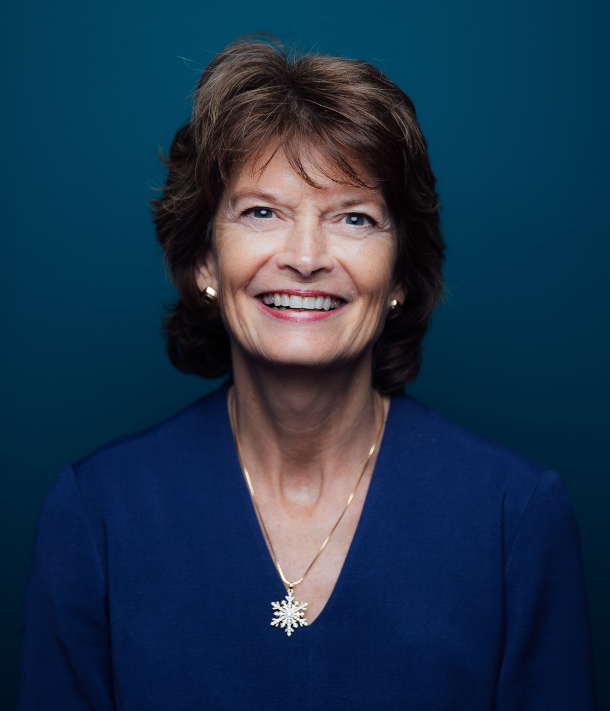
Lisa Murkowski is a Republican US Senator from Alaska and has been a strong supporter for oil expansion in the state. (Photo: US Senate, Public Domain)
CURWOOD: Now, the Biden administration, the same time it announced that they were approving this said, oh, we're going to have increased protection in the Arctic Ocean against petroleum extraction. How permanent are those protections? In other words, what are the chances that those protections can get thrown under the bus by another administration?
PARENTEAU: Yeah, so the White House called it a firewall. And that's probably an appropriate term, which means that what they're doing is expanding areas of the Beaufort Sea and the Chuckchi Sea from any further oil and gas development. President Obama created these so called safe zones or marine sanctuaries and so Biden is now basically expanding on those, and that's a good thing but it's not permanent, another administration can come in and make a different decision. The term firewall means it would be more difficult for a future administration to reverse course and that's true, they'd have to have some justification for that but it's not to say they couldn't do that. The other thing is, it's pretty clear that the oil industry is not really interested in further development of the Arctic Ocean. The banks are not interested in funding that, the Shell company sank something like $4 billion into an earlier attempt to get into the Arctic, they had one of their icebreaker ships actually frozen in the ice, it couldn't get through the ice. So, you know, it's good that Biden has said, no more drilling in the Arctic Ocean, but that wasn't probably going to happen anyway. A more significant concession, I think, is that the President has now also ruled out any further development of the North Slope Area, the National Petroleum Reserve area, that is significant. Again, it isn't permanent in the sense that it could never be undone but it was a good thing. It doesn't really offset, frankly, the harm that's caused by the Willow Project. And by the way, you know, this is not one like some of the others where courts have ordered the administration to issue leases, nor has Congress, by the way. So neither Congress nor the courts are ordering Biden to do this. He's making this decision on his own and he's just gonna have to own it.
CURWOOD: What does this decision do to the reputation of the United States in the international community that we are pushing to deal with climate disruption?

Mary Sattler Peltola is an American politician and former tribal judge serving as the U.S. representative from Alaska's at-large congressional district and a supporter of the Willow Project. (Photo: House of Representatives, Public Domain)
PARENTEAU: I think this sacrifices the United States credibility, look, we've already lost as a result of Trump's pulling us out of the Paris agreement, we lost a lot of credibility and when Biden agreed for us to re enter the Paris Agreement, a lot of the European nations and certainly a lot of the developing nations, China, India included, were very skeptical. Skeptical about the United States commitment to you know, climate solutions and to reforming its own carbon intensive economy. Remember, we per capita are the highest emitters of carbon in the world. So now we come along, having just you know, come back from a COP meeting in Sharm el Sheikh, trying to stimulate higher ambitions from other countries of the world, trying to convince countries like the Congo and Nigeria that have extensive oil and gas reserves, not to extract those and burn those reserves, but rather to transition to a more sustainable economy, now we come back and approved the largest oil and gas project and a very long time. And I don't know how we with a straight face, go to the next COP meeting and start pointing fingers at other nations to do better when we can't seem to model the behavior that we want to see from others.
CURWOOD: Some younger people are saying this decision by Biden is evidence that the fix is in. That despite promises of action certain powers that be are controlling things and part of that includes the fossil fuel industry. Your reading of this?
PARENTEAU: Yeah, I mean, the young generation, Gen Z's, really came out strong in social media against this project. They targeted this project as a test case for Biden's commitment to climate action, right, and the promises he made to stop drilling, and stop invading our most precious natural resources for the sake of the fossil fuel industry. And the fact that he has slapped them in the face with this decision, there's no other way to put it, I think there's going to be a consequence to that. They're not going to go vote for a Republican, they just might not vote at all. I mean, the last election, there was a record turnout of young voters and that's what propelled Biden to the White House. I'm sure he knows this and his, his staff knows this, but for some reason, they decided to not prioritize, I guess you'd say the youth vote on this one. And I don't know how they're going to restore confidence and gain back the active support, which they desperately need, if they're going to make another successful run for the White House. Time will tell, but this is a big blow I think to Biden's credibility with the younger generation.
CURWOOD: Pat Parenteau is a former regional counsel for the Environmental Protection Agency and emeritus professor of law at the Vermont Law School. Pat, always a pleasure to have you on the show.
PARENTEAU: Thanks very much Steve, enjoyed it.
Related links:
- CNN | “The Willow Project Has Been Approved. Here’s What to Know About the Controversial Oil-Drilling Venture”
- Scientific American | “Environmental and Indigenous Groups Sue over Willow Oil-Drilling Project”
- The Center for Biological Diversity | “Biden Administration Sued Over Willow Oil Project in Alaska’s Western Arctic”
- Read the lawsuit filed by Trustees for Alaska against President Biden’s approval of the Willow Project
- Read the lawsuit filed by Earthjustice against President Biden’s approval of the Willow Project
[MUSIC: Esperanza Spalding, “If That’s True” on Esperanza, by Baden Powell, Heads Up Music]
CURWOOD: Coming up – news from the frontlines in the fight for biodiversity in Africa. Keep listening to Living on Earth.
ANNOUNCER: Support for Living on Earth comes from Sailors for the Sea and Oceana. Helping boaters race clean, sail green and protect the seas they love. More information @sailorsforthesea.org.
[CUTAWAY MUSIC: Esperanza Spalding, “Samba em Preludio” on Esperanza, by Baden Powell, Heads Up Music]
Beyond the Headlines

A new study found that toilet paper is a major source of toxic forever chemicals. (Photo: Kev Bation, Unsplash)
CURWOOD: It’s Living on Earth, I’m Steve Curwood.
And it’s that time in the program when we peek beyond the headlines with Living on Earth contributor Peter Dykstra. He spoke with our Bobby Bascomb.
BASCOMB: Hey there, Peter, what do you have for us this week?
DYKSTRA: Well, hi, Bobby, though in recent years, there's been a lot of reporting about forever chemicals, the PFAS chemicals, 14,000 different chemicals, many of which come into contact with humans all the time. But there's new research from the University of Florida that says one source of PFAS forever chemicals isn't something we touch. It's something that touches us nearly everyday.
BASCOMB: Oh, what's that?
DYKSTRA: Toilet paper?
BASCOMB: Oh, no.
DYKSTRA: There's a new research finding. Not only that human skin in the most delicate places, comes into contact with paper that has some level of PFAS chemicals in it. But once that toilet paper is used and flushed, goes to sewage plants that aren't designed to treat chemicals like PFAS. They're only designed to treat biologicals, like we find in our own excretions those chemicals and many others go through the sewage plants and end up in our waterways, giving forever chemicals another way to harm people and to harm the ecosystem.
BASCOMB: Sure, plenty of it could end up in the waterways. And some of that sludge is actually used for fertilizer might wind up on our gardens and farmer's fields.
DYKSTRA: And we're just beginning to learn what the level of harm and level of risk is. But the more we hear about forever chemicals, the worse the prospects seem to be.
BASCOMB: Well, what else do you have for us this week?
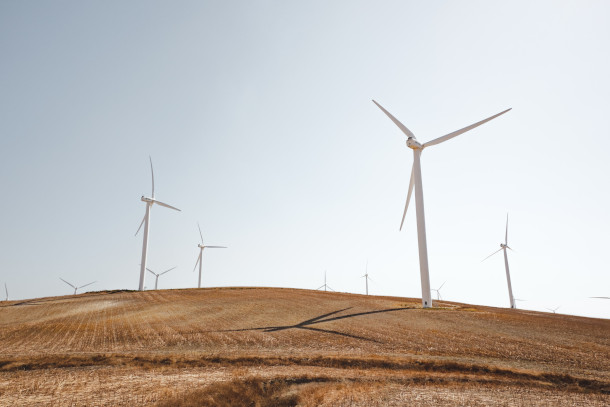
Texas has produced more renewable energy than any other state. (Photo: Luca Bravo, Unsplash)
DYKSTRA: There's one state that generates more renewable energy than any other, not California, not an environmentally super conscious state like Vermont, it's Texas, the oil land, it's been true for a long time, renewables are big in Texas, just like everything else, mostly in the realm of wind energy, and utility scale solar, they are second to California. But they're catching up quickly.
BASCOMB: Well, you know, we do, of course, associate Texas with oil, but it's a very sunny state and more than half again, bigger than California. So I suppose we shouldn't be too surprised.
DYKSTRA: Oklahoma is also a traditional oil and gas state that's making a huge mark, particularly on wind power. And when states like that can begin to see an alternative to oil and gas. It's one source where maybe we can be a little bit more hopeful on dealing with climate change.
BASCOMB: Well, what do you see for us from the history books this week?
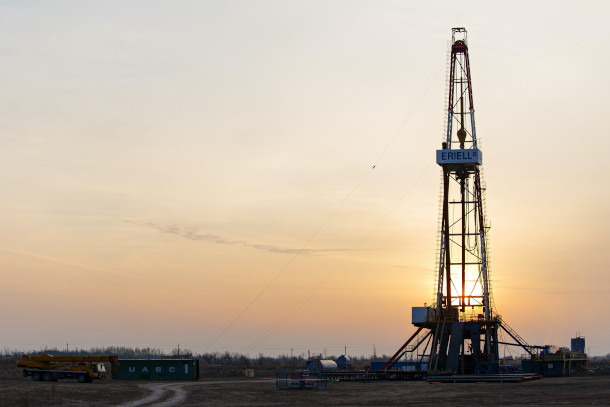
On March 13, 1968, The Atlantic Richfield Company and Humble Oil and Refining Company announced the discovery of oil on the North Slope of Alaska at Prudhoe Bay. (Photo: WORKSITE Ltd., Unsplash)
DYKSTRA: March 13th 1968, oil is discovered on Alaska's north slope, forever change not only the state's economy, but of course, the state's environment as well. It was less than a decade later, in the 70s, that the Alaska pipeline was passed by Congress funded, built and put underway bringing oil from Native communities in the North Slope all the way down to the port of Valdez, where it was put into tankers and shipped to refineries, mostly in the West Coast of the US.
BASCOMB: Right. And of course, you know, it's been decades, but the controversy about drilling in Alaska persists. And President Biden recently gave the green light for a new oil project, the Willow Project that we heard about earlier in the show.
DYKSTRA: Yeah. And it angers environmentalists largely because Biden had said at one point, that there would be no new oil and gas drilling on American public lands. That's something that appears to have gone by the boards, and we'll see what happens from here.
BASCOMB: All right, Peter. Peter Dykstra is a contributor to Living on Earth. Thanks so much. We'll talk to you again real soon.
DYKSTRA: Okay, Bobby, thanks a lot. Talk to you soon.
BASCOMB: And there's more on the stories on the living on Earth website. That's LOE dot ORG.
Related links:
- The Guardian | ”Toxic ‘Forever Chemicals’ Found In Toilet Paper Around The World”
- Inside Climate News | “One State Generates Much, Much More Renewable Energy Than Any Other—and It’s Not California”
- Energy.Gov | “March 13, 1968: Oil Discovered On Alaska's North Slope”
[MUSIC: Alaska Blue, “Fade Away” on Under the Weather, Alaska Blue]
EPA Drops the Ball in East Palestine

Drone footage shows the freight train derailment in East Palestine, Ohio, February 6, 2023. (Photo: National Transportation Safety Board, public domain)
CURWOOD: The train derailment in East Palestine, Ohio in February sparked fires and dumped toxic chemicals into the water, soil, and air. And to avoid a potentially catastrophic explosion local authorities drained more than 100,000 gallons of deadly vinyl chloride into a ditch and set it on fire. Local people are concerned for their health as the burning of vinyl chloride can change its chemistry and convert it into the highly toxic chemical family of dioxins. The Environmental Protection Agency has been slow and weak to respond, according to commentator Judith Enck, a former regional administrator of the EPA.
ENCK: When they burned the vinyl chloride officials didn’t mention the plume that could rain down dioxins and other enduring poisons in the region. And two days after the burn, residents in the evacuation zone were allowed back into their homes — before any testing for dioxins and other contaminants on the surfaces inside had been done.
Dioxins are some of the most potent carcinogens on earth — there’s no “safe” dose for humans, and pregnant women and young children are especially vulnerable to their effects.
But even now, more than a month after the derailment, the people of East Palestine don’t have solid information about the risks they and their families face — whether they have already been exposed, what they should be doing to avoid future exposure and whether they just need to move.
The Environmental Protection Agency should have ordered comprehensive testing the very day of the burn. It should have told residents, especially pregnant women and families with young children, not to return home until it was safe to do so. Instead, it timidly stood back, leaving local authorities, corporate interests and rumors to fill the void.
In lieu of a comprehensive plan, the E.P.A. appears to be playing a game of crisis whack-a-mole, waiting and then responding to the news cycle. This is no way to safeguard our communities.
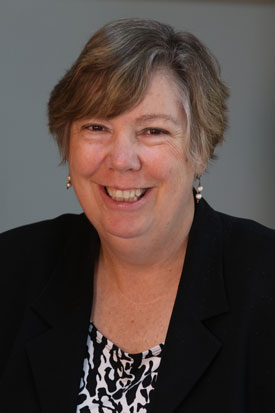
Judith Enck is founder and President of Beyond Plastics, Professor at Bennington College in Vermont and former Regional Administrator for Region 2 of the EPA. (Photo Courtesy of Judith Enck)
In a situation like this, the E.P.A. should immediately conduct authoritative tests and come up with a plan to address any dangers, and communicate all of it loudly and clearly to the affected communities. Instead it waited a full month, and then, amid public outrage, asked the railroad company to test for dioxins and come up with a plan.
This is a terrible approach, the interests of a company accused of polluting are quite obviously distinct from those of the public.
By acting as a reluctant regulator, the E.P.A. has left the residents of East Palestine and the surrounding areas desperate for answers. These are people who are concerned for their health, the safety of their own homes and the well-being of their children. They deserve better.
The E.P.A. needs to take two actions now.
First, it needs to conduct comprehensive environmental testing for dioxins in and around East Palestine.
Second, the E.P.A. needs to establish federally funded medical monitoring for everyone along the plume. Even those who appear healthy now should be offered baseline testing.
Whether you live in a blue, red or purple state, the E.P.A. should work aggressively to protect your health and the health of your families during environmental emergencies. The people of East Palestine and their neighbors have been through a lot. The E.P.A. will need to work hard to regain their trust.
CURWOOD: Judith Enck is founder of Beyond Plastics and a former regional administrator for the EPA.
Related links:
- Watch “The True Cost of Plastics” video from Beyond Plastics
- Find EPA updates on the emergency response to the East Palestine, Ohio train derailment
- ICYMI: Listen to Living on Earth’s interview about the growing concern over dioxins in the aftermath of the disaster
[MUSIC: Esperanza Spalding, “Ponta De Areia” on Esperanza, by Baden Powell, Heads Up Music]
The Next Chapter of the Living on Earth Book Club

CURWOOD: In the coming decades millions of Americans will be uprooted by wildfires, floods, heat waves, and rising seas in the largest migration in our country’s history. And some have already begun to move. The new book “The Great Displacement: Climate Change and the Next American Migration” tells their stories and uncovers how government and insurance policies are shaping who rebuilds and who retreats. Author Jake Bittle will join the Living on Earth Book Club on March 23rd, and you’re invited! Tune in at 3 p.m. Eastern to our livestream. To find out more and register for this free event go to loe.org/events.
By the way, we’ve got 20 signed copies to give away to folks who contribute $75 or more to help support free events like this one. Just go to the Living on Earth website at loe dot org and click on Donate at the top of the page to secure your copy. And thank you!
Related links:
- CLICK HERE to register for this upcoming live event
- Purchase a copy of ‘The Great Displacement: Climate Change and the Next American Migration’ (Affiliate link helps donate to LOE and local indie bookstores)
[MUSIC: Esperanza Spalding, “Ponta De Areia” on Esperanza, by Baden Powell, Heads Up Music]
Saving the Second Lung of the Planet

Aerial view of village in Lac Paku in the peatland forest near Mbandaka, Democratic Republic of the Congo. The Congo peatlands are the most carbon-rich tropical region in the world and are estimated to store the equivalent of three years’ worth of total global fossil fuel. (Photo: Courtesy of Greenpeace Africa)
CURWOOD: The fifteenth conference of the parties of UN Biodiversity treaty in Montreal, Canada late last year led to an agreement to address biodiversity loss, restoration of ecosystems, and protection of indigenous rights. Nations pledged at COP15 to protect 30 percent of the planet by the year 2030 and mobilize at least $200 billion a year in funding. They also agreed to send $30 billion a year from developed nations to the developing ones that contain most of the world’s biodiversity. Concerned scientists hope it’s not too little too late. Already there has been a nearly 70 percent decline in the world's animal populations since 1970, according to a World Wildlife Fund study. Not only are the Amazon and Asian rainforests under threat, the Congo Basin in Central Africa is also a critical biodiversity hotspot and a linchpin in the fight against climate disruption. For more I’m joined by Irene Wabiwa. She is an international Project Leader for Greenpeace Africa based in the Democratic Republic of Congo and attended COP15 in Montreal. Welcome to Living on Earth!
WABIWA: Thank you.
CURWOOD: I want you to give us the big picture here. Why is biological diversity a global issue? In other words, why is there an international convention on it?
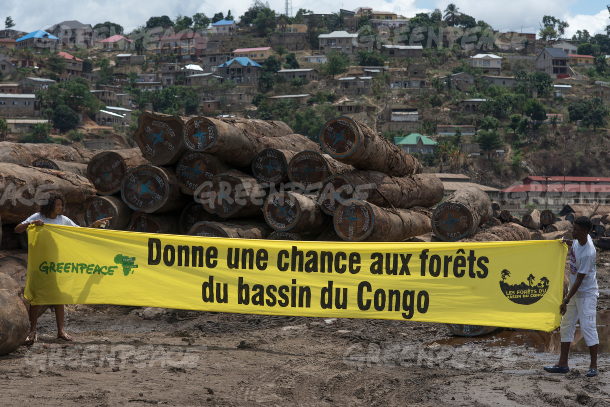
A yellow banner reading 'Donne une chance aux forêts du bassin du Congo', French for "Give Congo Basin forests a chance" is displayed on harbour logs at the terminal in Matadi, DRC. (Photo: Courtesy of Greenpeace Africa)
WABIWA: Yeah, that is a very huge question but very good one. You know, the global biodiversity loss is at the heart of the planetary emergency, the planetary crisis that we are all facing now. As the climate change, the biodiversity crisis is also becoming a real threat to the planet. So to protect the important ecosystem and habitat, to preserve the natural environment that is key to our own well being, the global community must take action now and collectively, and that's why the global biodiversity agreement is really, really necessary. The targets have been set in Montreal, we now need to quickly move from papers to implementation from speeches, from signature, to action on the ground, including the mobilization of finance. Without the appropriate finance the biodiversity crisis that we are facing, that is changing our life, day to day will be there and we will continue to struggle as we are struggling.
CURWOOD: How do the financing commitments made in Montreal at the biodiversity cop 15 compared to the need?
WABIWA: The finance issue was one of the most tricky issues at the Montreal conversation, we should say that there's clearly a huge biodiversity finance gap. Estimates are suggesting up to 700 billion US dollars annually that is needed to protect nature. But in Montreal, government has agreed to mobilize at least 200 billion US dollars per year, you can see that is not enough.
CURWOOD: Now, my understanding is that indigenous lands make up about 20% of the Earth's territory, and have about 80% of the world's remaining biological diversity. To what extent can lands occupied by indigenous people be conserved without bringing indigenous peoples into the discussion indeed, giving them credit for their stewardship over all these millennia?

Aerial view of Monboyo River and peatland forest of Salonga National Park south-east of Mbandaka, Democratic Republic of the Congo. (Photo: Courtesy of Greenpeace Africa)
WABIWA: We have so many examples, unfortunately. And in the Congo Basin region, which is the second largest rainforest of the world, is a region that is composed by six countries, we could see many countries like in Cameroon, in the Republic of Congo, where communities have been displaced from their land because the country has decided to create a national park. We have the example of Kahusi-Biega National Park where indigenous people have been asked to move away very far from their traditional lands because that land has become a national park. They were not consulted, they were not informed. They only saw conservationist coming to ask them to move because they need to protect that forest. And if this decision was taken to transform that land that piece of land into a national park it's because those indigenous people have been protecting this land for many decades, otherwise, they couldn't find anything. And instead of recognizing the efforts of those communities, and involve them in management, creation of National Park decision making, they just move them away. And that is not fair. No deal on biodiversity or nature protection can be successful if the rights of communities and induce people that are the best guardian of this ecosystem are not respected. We are happy that the deal in Montreal recognized the rights of communities, their free and prior informed consent to be respected. But we need to see those targets being implemented transformed into action, decision on national level.
CURWOOD: The Congo Basin, of course, is the world's second largest tropical rainforest after the Amazon, and some would say it is the most intact tropical rainforest. Describe it for us if you could, talk about the plants and animals and people who can be found in the Congo Basin.
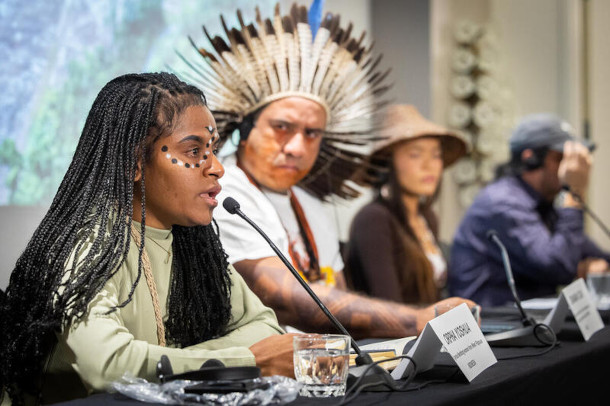
At a press conference in Montreal’s COP15, global Indigenous leaders from Brazil, Canada, the Democratic Republic of Congo, Cameroon and Indonesia gathered to call for nature protection that centers Indigenous rights and shifts power from industry to Indigenous Peoples and local communities. (Photo: Toma Iczkovits, Greenpeace Africa)
WABIWA: The Congo Basin is really, its rich, it's beautiful. It's one of the most important wilderness area left on the on the earth, if not the intact area left on the earth, as you were saying. It represents 70% of the African continent plant cover, so it's huge, it's rich. About 26% of the planet rainforest is lying in the Congo Basin. It has a lot of rivers, a lot of savannas. We have the biggest tropical peatland in the Congo Basin. It's also a home to large mammals such as gorillas, elephants, buffalo, many other species that you can only find in that region. We're talking about over 11,000 species of tropical plant and more than 1,200 species of birds, 700 species of fish. So it's an area that needs to be protected, the second lung of the planet and if the coming Montreal deal need to be a reality, need to be successful, that means the Congo Basin as a region need to be protected at any costs.
CURWOOD: Now, as I understand it, the peatlands in the Congo and Central Africa there are the world's largest tropical peatlands complex. I think there's some 16 million hectares there, that will be bigger than England and Wales combined. And they've been managed sustainably by local communities for hundreds of years. Now, according to scientists, they hold some 30 billion metric tons of carbon, that's more emissions than the US emits every year. What are some of the dangers facing the peatlands?
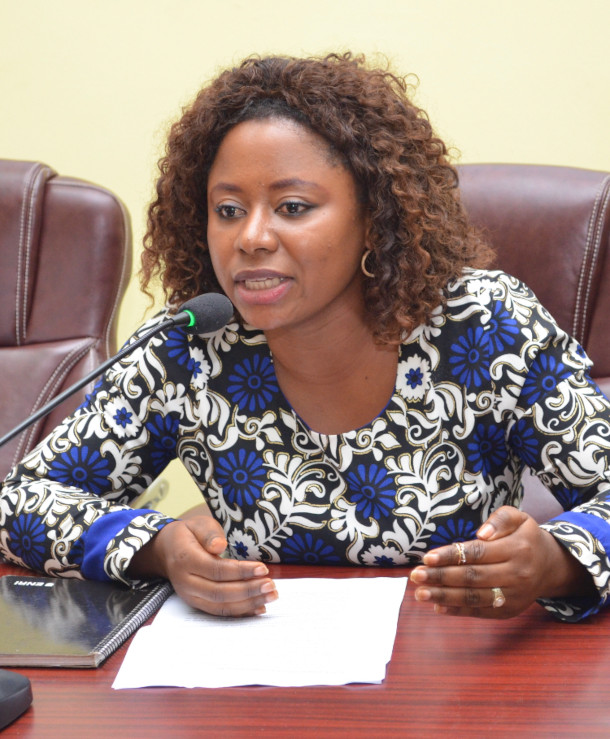
Irene Wabiwa is the Forest Campaign Lead for the Congo Basin forest at Greenpeace Africa. (Photo: Courtesy of Greenpeace Africa)
WABIWA: Exactly. The Congo Basin is the largest complex of tropical peatlands in the world. And this very sensitive complex has been protected by communities again, and indigenous people since it's existence. And as you were saying, they store almost 30 billion tons of carbon, the equivalent of three years of global emissions from fossil fuel but unfortunately these peatlands are facing some serious threat. Taking the example of the DRC, where more than 19 billion tons of carbon are lying, the DRC Government has decided to auction 27 Old blocks, including in the forest protected area and the same peatland. And according to the scientists, if these oil concessions are not stopped more than one million hectare of those peatlands will be impacted by the oil activities. And talking about forest more than eleven million hectares of forest that is huge will be impacted. So if the oil blocks are not stopped in the DRC, which is more than 60% of the Congo Basin rainforest, this huge environmental disaster will impact our humanity, our planet, and our life will never be the same. That's why we're calling the DRC government to stop it's oil auction and preserve the future of the humanity.
CURWOOD: Irene Wabiwa is the international project leader for Greenpeace Africa. Thanks so much for taking the time with us today.
WABIWA: Thanks a lot Steve.
Related links:
- Learn more about UN Biodiversity COP15
- The Guardian | “COP 15 In Montreal: Did the Summit Deliver for the Natural World?”
- Follow Irene Wabiwa on Twitter
- Learn more about Greenpeace Africa
- Bloomberg | “Congo Peatlands, Which Slow Climate Change, Bigger Than Thought”
- Check out the Mongabay Series on the Congo Peatlands
- Listen to Living on Earth’s conversation with Senior Reporter for Mongabay John Cannon on the Congo Peatlands
[MUSIC: Orchestra Baobab, “El Sow Te Llama” on Specialist in All Styles, by Jose Marquetti, Nonesuch Records, a Warner Music Group Company]
CURWOOD: Coming up – Primatologist and activist Jane Goodall on holistic approaches to sustainable development and conservation. Stayed tuned Living on Earth.
ANNOUNCER: Support for Living on Earth comes from Friends of Smeagull the Seagull and Smeagull’s Guide to Wildlife. It’s all about the wildlife right next door to you! That’s Smeagull, S - M - E - A - G - U - L - L, SmeagullGuide.org.
[CUTAWAY MUSIC: Jacqueline Schwab, “Hymn to the Big Sky” on True Blue Waltz, by Joe Weed, Midsummer Recordings]
Jane Goodall on Helping People to Help Nature

Local Voices, Local Choices: The Tacare Approach to Community-Led Conservation is the new book from the Jane Goodall Institute, with an introduction by Dr. Jane Goodall. (Photo: courtesy of the Jane Goodall Institute)
CURWOOD: It’s Living on Earth, I’m Steve Curwood.
Jane Goodall is most famous for her groundbreaking work with chimpanzees in Tanzania. But she’s also a conservation activist and in 1977 co-founded the Jane Goodall Institute with a mission to protect habitat worldwide by empowering local communities to develop sustainably. A new book from the Jane Goodall Institute chronicles the stories behind its holistic approach to solving conservation challenges. The book title is “Local Voices Local Choices: The Tacare Approach to Community-Led Conservation” and joining me now to discuss it is Jane Goodall. Welcome back to Living on Earth!
GOODALL: Thank you.
CURWOOD: So in a nutshell, what is the Tacare approach to conservation? And how did it come about?
GOODALL: Well, in 1986, there were a total of six different chimpanzee study sites across Africa. When I began, it was just me. And so with the head of the Chicago Academy of Sciences, we decided it would be really good to bring the scientists from each of these sites together for a four day conference. The main purpose was to see whether chimp behavior differed in relationship to different environments, and if so, how, and was there something like culture, which I maintained, and which turns out to be true. But also we had a session on conservation and it was absolutely shocking because it was clear that right across Africa, chimpanzee numbers were decreasing, and forests were being destroyed. So I went to that conference as a scientist, I left as an activist. And I knew I had to do something, I hadn't a clue what to do, but got some money together, and visited these different sites. But even as I was learning about the problems faced by the chimps, I was learning about the plight of so many African people living in and around chimpanzee habitat, the crippling poverty, the lack of health and education facilities, the degradation of the land, as the human population grew and moved into chimpanzee habitat. And it came to a head when I flew over the tiny Gombe National Park, which had been part of a forest belt right across Africa. And when I looked down in the late 1980s, it was just a little island of forest surrounded by bare hills, more people than the land could support too poor to buy food elsewhere, cutting down trees to make money from timber, or charcoal, or to make more land to grow food for their growing families. And that's when it hit me. If we don't help these people find ways of making a living without destroying the environment, we can't save chimps, forests or anything else. And that was how Tacare began. And then, you know, as the villagers came to trust us, then we could introduce more than just growing more food and better health and education. We could introduce water management programs, scholarships, to give girls a chance to secondary education, microcredit, so that people could start their own small, environmentally sustainable businesses, and family planning.

Dr. Jane Goodall has been working in the field of conservation for over 60 years. (Photo: Andrew Zuckerman, courtesy of the Jane Goodall Institute)
CURWOOD: So in these 60 plus years, what have you heard from local people near Gombe and Lake Tanganyika about how they feel about their forest and taking care of it.
GOODALL: As we work more and more closely with the local people, and they've learned to record the health of their forests, they really have understood the importance of the forest in their lives, that it helps to regulate temperature, that it provides shade, that it keeps moisture in the ground, regulates rainfall to some extent. And we introduced shade grown coffee that's put in coffee under the trees of the forest. So that really helps biodiversity and provides really good quality coffee. So it has won many prizes on the main coffee market of Tanzania. Five years running. Yeah.
CURWOOD: What's the brand of it by the way?
GOODALL: Well, it's in different countries, it's sold under different names. Gombe Reserve is the typical name in the US.
CURWOOD: So near Gombe, these communities are very remote and fairly traditional societies. How does your approach, how does the Tacare approach help them retain their traditions and cultural identity while allowing them to reap some of the benefits of modern society?

The Tacare Approach was first developed to help the people living near Gombe National Park in Tanzania, where Dr. Goodall began studying chimpanzees in 1960, to more sustainably manage their land, reducing deforestation and environmental degradation. (Photo: Kristin J. Mosher, courtesy of the Jane Goodall Institute)
GOODALL: Well, because we respect their traditions, and because, for example, we've managed to persuade the traditional healers, they used to be witch doctors, it used to be you only passed your knowledge from father to son, I don't think ever to a daughter. And so traditions were in danger of dying out. So we managed to persuade them to get together and they agreed to share their knowledge for the benefit of all the local people. And we started trying to grow some of the medicinal herbs. Interestingly, chimps and humans use very much the same plants to cure particular diseases. Who taught who? We don't know.
CURWOOD: What's up common plant for healing that both chimps and humans use there?
GOODALL: Well Aspilia is a certain leaf that they use for tummy upsets, things like that.
CURWOOD: We have a lot to learn from nature.
GOODALL: Yes.
CURWOOD: So, these days, you now have this program for young people you call Roots and Shoots. Tell us about that, I mean, you know, we're not exactly the youngest people in the world, Jane Goodall and myself. So the next generation is going to have to do a whole bunch of things. How does the roots and shoots youth program help develop leaders for the Tacare initiative to go forward?

Roots and Shoots is the Jane Goodall Institute’s youth conservation program, with chapters in over 60 countries. (Photo: Mary Paris, courtesy of the Jane Goodall Institute)
GOODALL: Well, it began in 1991. All the time, you know, way back in the late 1980s, when I was already traveling around the world, giving lectures, raising awareness, and trying to raise funds as well, of course, I was meeting young people, high school, university, who already were losing hope. And they were either depressed, angry, or mostly just apathetic. And they told me when I asked, and this is all around the world really, "well, you've compromised our future, there's nothing we can do about it." Well, we have compromised their future, in fact we've been stealing it, we still are. But it's not true, there is something they can do about it, that there's a window of time, if we get together, we can start to heal some of the scars we've inflicted on poor old planet Earth, slow down climate change, slow down loss of biodiversity, these two existential threats that we face. So the young people, they form groups, and in that group, they discuss what they care about in their environment. Some of them care about people, poverty, homelessness, some of them care about animals, protection in the wild, conditions in captivity, some of them care about the environment, you know, looking after, protecting forests, growing organic food, having butterfly gardens. And so then they discuss what they can do, roll up their sleeves, get out there and do it. And what began with 12 high school students in Tanzania, is now in 68 countries around the world, members from kindergarten through university, even adults now forming groups, and they are changing the world. I talked about the bare hills, around Gombe back in the late 80s. Those bare hills aren't there anymore, the trees are coming back from seeds left in the ground, or from big tree planting operations conducted by Roots and Shoots for the main part. And with the trees coming back, so biodiversity comes back. And the one thing that they seem to keep with them, they have this respect, respect and compassion, respect for each other and the animals and the environment. And they're caring. So we're producing, yes, we are producing leaders of the next generation. But even more important, I think, we're producing caring and compassionate citizens, because not everybody is going to be a leader.
CURWOOD: So, I recall the story of a young Jane Goodall who went to this part of Tanzania, and was, you know, they acted like they thought you were crazy. To what extent do people who do this work have to be rebels do they have to say, no, no, no, no, no, we can't do it the old way, we have to do it a better new way?

Dr. Goodall first traveled to Gombe National Park with her mother, Margaret, who set up a medical clinic for the local communities. (Photo: Hugo Van Lawick, courtesy of the Jane Goodall Institute)
GOODALL: Well, I was 10 years old, when I met this opposition to my dream of going to Africa, living with wild animals and writing books about them. Jane, dream about something you can achieve, how will you get to Africa, you don't have money, Africa's far away, it's dangerous, it's the dark continent full of dangerous animals and people. And I was just a girl. And it was my mother who said, Jane, if you really want to do this, you're going to have to work really hard, take advantage of every opportunity and, if you don't give up, hopefully, you'll find a way. So my mother supported me. And my family actually, it was everybody else who didn't. And then once I got there, I met Louis Leakey and he gave me this amazing opportunity to live with not just any animal, but the one closest to us, the chimpanzee. Then, you know, there was money only for six months. I mean, who was going to give money? Young girl, hadn't been to college, straight out from England. And I was really afraid that I wouldn't find out anything really useful and my dream would end because the chimps ran away from me to start with and then this one chimpanzee, male, David Greybeard, gentle disposition, very handsome, probably about 25 years old, for some reason, he began to lose his fear of me before the others. It was he whom I saw using and making tools to fish for termites, which was supposed to be unique to us, we were the only tool-using, tool-making animal. And it was that that brought in the National Geographic Society. And then I could stay on. And the local people, when I first arrived, they thought, "oh, Jane will last, maybe one or two weeks, and then she'll go," but of course, they were wrong. I didn't feel I was rebelling. But I think what's needed for people doing something like this is passion, you need to be absolutely passionate about it, and then determined that you're going to succeed and know that you're on the right path.
CURWOOD: Jane Goodall, as we're speaking to you in March of 2023. This month is also Women's History Month. So let me ask you, how has the world of science changed for women since you started this work? And what are the challenges that you think women still face?

Dr. Jane Goodall was the first to observe chimpanzees making and using tools to fish for termites. (Photo: Nick Riley, courtesy of the Jane Goodall Institute)
GOODALL: Science has changed for women hugely since I was young, because, you know, when I was dreaming of Africa and animals, I didn't dream of being a scientist, because girls simply didn't do that sort of thing. And gradually, it's changed. And gradually, more and more women are coming into science. I think one problem at one time was that science, it was very cold. The early ethologists, those studying animal behavior, were extremely reductionist. For example, I was told you shouldn't have named the chimpanzees, they should have had numbers, that's scientific, you cannot talk about their personalities, their minds, or their emotions, those are unique to us. You cannot be showing empathy for your subjects. To be a good scientist, you must be objective, coldly objective. And of course, anybody who's shared their life with a dog, a cat, a rabbit, a horse, I don't care what animal, knows that that's wrong. And I'm sure those early scientists didn't really believe it, but they couldn't prove it. And it was the chimpanzees that really broke that model. Because once the film shot by my husband, Hugo van Lawick, began going around the world, then you could see with your own eyes, of course chimpanzees have many of the emotions we have, and the postures and the gestures that we have. And so gradually, now, we're studying the emotions and the incredible intelligence of, for example, the octopus, you know, "My Octopus Teacher." Octopuses are amazingly intelligent. Crows. Crows can solve some problems faster than an eight year old human child, unless they're a genius child. So I think that women were put off by this coldness, to some extent, but now it's got warmer. And I think that's encouraging a lot of girls to go into science. And I have to say it that hundreds have said to me, "Jane, it was after I heard your lecture or saw your film, that I decided this was what I was going to do. Because you did it, I can do it too." Whatever it is, just if they had a dream, not to listen to people who said you can't do that. But to follow it, just as I followed mine.
CURWOOD: The new book from the Jane Goodall Institute with an introduction by Dr. Jane Goodall herself, "Local Voices, Local Choices: The Tacare Approach to Community-Led Conservation" is a guidebook for effective and enduring sustainability and an inspiration to anyone trying to make a difference in this world. Jane Goodall, thank you so much for joining us again. We hope to see you again soon in another couple of years.
GOODALL: Thanks so much for inviting me.
CURWOOD: And it's a little early but, happy birthday.
GOODALL: Thank you. Well, next year I'll be 90. How about that?
CURWOOD: There you go. Well, the world needs you so let's keep you around.
GOODALL: Thanks.
Related links:
- The Jane Goodall Institute
- Roots & Shoots USA
- Find the book “Local Voices, Local Choices” (Affiliate link helps donate to LOE and local indie bookstores)
[MUSIC: Keola Beamer, “Hula Lady” on Wooden Boat, by Carlos Andrade and Vinnie Bryant, Dancing Cat Records]
CURWOOD: Next time on Living on Earth, a plan from the EPA to protect drinking water from PFAS chemical pollution.
[MUSIC: Keola Beamer, “Hula Lady” on Wooden Boat, by Carlos Andrade and Vinnie Bryant, Dancing Cat Records]
CURWOOD: Living on Earth is produced by the World Media Foundation. Our crew includes Fern Alling, Naomi Arenberg, Bobby Bascomb Paloma Beltran, Iris Chen, Josh Croom, Jenni Doering, Swayam Gagneja, Mark Kausch, Mark Seth Lender, Don Lyman, Jusneel Mahal, Louis Mallison, Aynsley O’Neill, Sophia Pandelidis, Jake Rego, El Wilson, and Jolanda Omari. Tom Tiger engineered our show. Alison Lirish Dean composed our themes. You can hear us anytime at L-O-E dot org, Apple Podcasts and Google Podcasts, and like us, please, on our Facebook page - Living on Earth. We tweet from @livingonearth. And find us on Instagram at livingonearthradio. And you can write to us at comments at loe dot org. I’m Steve Curwood. Thanks for listening!
ANNOUNCER: Funding for Living on Earth comes from you, our listeners, and from the University of Massachusetts, Boston, in association with its School for the Environment, developing the next generation of environmental leaders. And from the Grantham Foundation for the protection of the environment, supporting strategic communications and collaboration in solving the world’s most pressing environmental problems.
ANNOUNCER 2: PRX.
Living on Earth wants to hear from you!
Living on Earth
62 Calef Highway, Suite 212
Lee, NH 03861
Telephone: 617-287-4121
E-mail: comments@loe.org
Newsletter [Click here]
Donate to Living on Earth!
Living on Earth is an independent media program and relies entirely on contributions from listeners and institutions supporting public service. Please donate now to preserve an independent environmental voice.
NewsletterLiving on Earth offers a weekly delivery of the show's rundown to your mailbox. Sign up for our newsletter today!
 Sailors For The Sea: Be the change you want to sea.
Sailors For The Sea: Be the change you want to sea.
 The Grantham Foundation for the Protection of the Environment: Committed to protecting and improving the health of the global environment.
The Grantham Foundation for the Protection of the Environment: Committed to protecting and improving the health of the global environment.
 Contribute to Living on Earth and receive, as our gift to you, an archival print of one of Mark Seth Lender's extraordinary wildlife photographs. Follow the link to see Mark's current collection of photographs.
Contribute to Living on Earth and receive, as our gift to you, an archival print of one of Mark Seth Lender's extraordinary wildlife photographs. Follow the link to see Mark's current collection of photographs.
 Buy a signed copy of Mark Seth Lender's book Smeagull the Seagull & support Living on Earth
Buy a signed copy of Mark Seth Lender's book Smeagull the Seagull & support Living on Earth

